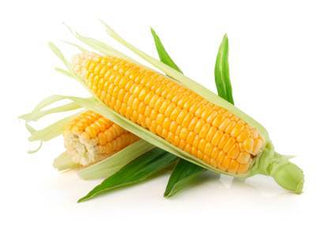(Zea Mays)
A summer favorite that should be enjoyed at every barbeque is fresh corn on the cob. Known as maize by many cultures around the world, corn is a Native American tradition and an icon of American history. When we visualize corn, we see yellow kernels and green husk; however, there are many varieties of corn that vary in color such as red, pink, black and blue.
History
Corn originated in either Mexico or Central America. Corn has been an important food dating back to 7,000 years ago. The use of corn for shelter, decoration and fuel has been a tradition to Native Americans and still remains an important symbol in their culture. Corn was later introduced throughout the world after Spanish and Portuguese explorers brought maize to Europe.
Many of the European explorers coming to the new world did not follow Native American traditions. These included combining corn with beans to create a complete protein and using pot ash to release niacin (vitamin B3). This process involves burning limestone and adding the lime to the corn which makes the niacin easier to absorb. When corn became a staple food among non-indigenous Americans, many became victims of the vitamin B3 deficiency known as pellagra.
Native Americans also developed a tradition of planting called the three sisters. Squash, beans and corn were planted together on a hillside. The squash provided ground cover to prevent weeds from growing. The corn stalks provided a vine for the beans to grow upon. And, the beans provided nitrogen as part of the nitrogen fixing bacteria that live in the roots of beans and legumes.
Nutrition Facts
Although corn contains a small amount of fiber, the primary carbohydrate is starch. With age, the starch content of corn increases. One medium sized ear of yellow (or white) corn is slightly less than 80 calories. But, adding butter, a long-standing tradition, can quickly increase the calorie content.
Corn is a good source of thiamin, vitamin C, folate and niacin. It is also a good source of magnesium, potassium and manganese.
Yellow corn contains the carotenoids lutein and zeaxanthin. Kernels that are violet, blue and black indicate that the corn has a high level of plant pigments called anthocyanins, which are potent antioxidants. While not typically served on the cob, the darker corn varieties have a lower starch content and are used in chips, tortillas and other Mexican foods.
Selection & Storage
Locally-grown corn is widely available during the summer months. During the remainder of the year, fresh corn is shipped in from Mexico, Brazil and California. Be sure to select corn that is displayed in a cool area as the sugar will convert to starch if stored in a warm area. If shopping at a supermarket, select corn that is refrigerated. If shopping at a farmer’s market, select corn that is located in a shaded area.
Look for corn whose husks are fresh and green and not dried out. The kernels should be plump and arranged in neat rows. When pressed, the kernels should have a milky white juice.
Ideally, purchase corn the day you plan on enjoying it as corn loses its flavor quickly. If you do not plan to cook the corn right away, store it in a plastic bag with the husk intact and place it in the refrigerator. To savor the taste, consume within 1-2 days.
Recipes
Corn can be enjoyed many ways, on and off the cob. Try our Corn & Crab Chowder recipe. Here are several other ways to enjoy corn:
- Create your own corn relish using fresh corn, chopped red onion, chopped red and green peppers, pinto beans and tomatoes. Add some lime, chopped cilantro, pepper and salt to taste.
- Instead of adding butter to corn on the cob, add a little olive oil, pepper, red pepper and dash of salt.
- Sauté corn with peppers and onions to enjoy a side dish or a fajita entrée.
- Top a salad with corn kernels, black beans and sliced jicama to create a Southwestern dish.
- Add corn and diced tomatoes to guacamole to give it extra zing.
Another great way to enjoy corn is adding it to a homemade salsa. Eating Well Magazine offers a healthy, yet tasty Avocado-Corn Salsa to enjoy with blue corn chips.
Fun Facts
Looking for a different kind of family adventure? You don’t have to live in the Midwest to enjoy visiting a corn maze. To find one in your area visit The Maize or Corn Mazes America websites.
The starch from corn is used to make plastic, fabric, adhesive and other chemical products. It has also been used, in the form of high fructose corn syrup, as an added ingredient to a wide variety of packaged, processed foods, especially soft drinks. An ear of corn contains between 200 to 400 kernels.

